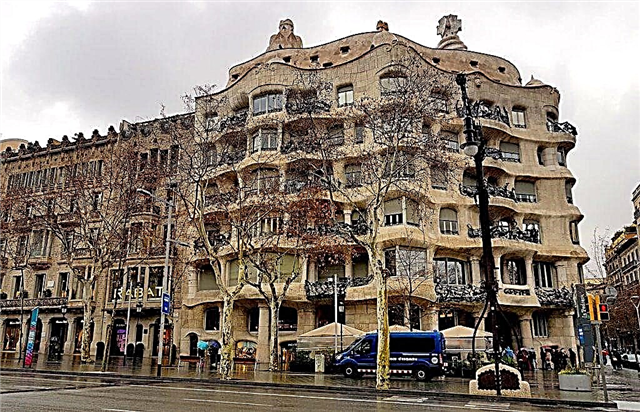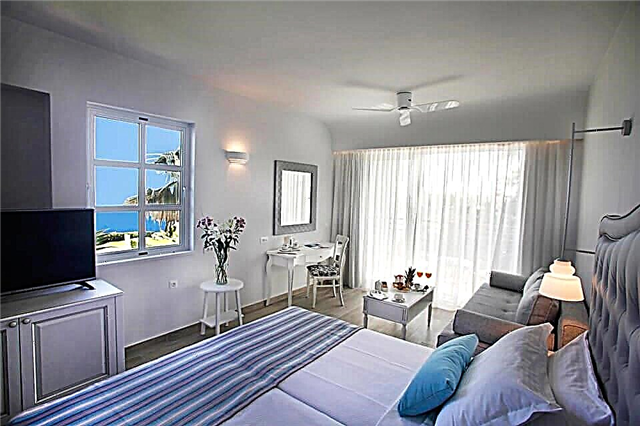Address: Moscow, Sadovaya-Kudrinskaya street
Start of construction: 1927 year
Completion of construction: 1929 year
Authors of the project: M.O.Barshch, M.I.Sinyavsky, G.A.Zundblat
Coordinates: 55 ° 45'41.2 "N 37 ° 35'01.4" E
Content:
Among the attractions that Moscow offers for children, many choose the Moscow Planetarium. There are only 16 cities in Russia where there are planetariums. The opportunity to see the stars and planets in all details is so attractive that on weekends and holidays a long queue is lined up at the box office of the capital's planetarium.

General view of the Moscow Planetarium
History of the planetarium
The planetarium in Moscow was built with money allocated by the Moscow City Council. It received visitors in November 1929 and became the very first in the country. The newly opened educational institutions were greeted with great enthusiasm. The planetarium was greeted by many scientists, and Vladimir Mayakovsky dedicated poetry to it.
The egg-shaped building was covered by a huge dome, and inside it was a hall for 1,400 spectators. For the projection of the night sky, the best German apparatus was used, which was created by specialists of the famous company "Carl Zeiss".
In the 1930s, the planetarium gave daily demonstration sessions and an astronomical circle for schoolchildren. In addition, pilots who had to work in the difficult conditions of the Arctic Circle were trained here.

Lunaria Museum at the Moscow Planetarium
When the space program was launched in the USSR, the planetarium began to be used to train the cosmonaut corps. Future conquerors of outer space were introduced to the basics of astronavigation, and by 1987 practically all Soviet cosmonauts had attended such classes. Many of them, having made a flight into space, gave lectures in the planetarium.
From 1994 to 2011, the building was closed for lengthy renovations. Today, the renovated planetarium has become a popular tourist attraction and educational center, which both residents of the city and tourists who come to the capital try to visit.

In the hall of the museum "Lunaria"
Great Star Hall
In terms of its size, the planetarium in Moscow is the largest in Europe. The Big Star Hall is covered by a dome with a diameter of 25 m, and its area reaches 1000 sq. m. As well as at the time of opening, German-made devices are used for demonstration sessions. This is justified, because the quality of Carl Zeiss fiber-optic devices is highly valued all over the world.
Thanks to the "Universarium M9", visitors receive an amazingly clear image. It allows you to feel the amazing beauty of the starry sky and the enormous scale of space. The impression from the visual range is complemented by vivid sound effects, so a visit to the planetarium turns into a real journey through space and time.
The showcase of stars and planets lasts for 20 minutes. The same amount of time is spent watching a popular science film about black holes and colliding galaxies.

Projector-planetarium "Universarium M9" in the Big Star Hall of the Moscow Planetarium
Small hall
The small hall occupies the lower level of the building and is used to show popular science films about the structure of the solar system, the work of astronomers, the history of observations of celestial bodies, the craters of the moon and space expeditions to Mars. In addition, lecture programs are held in the Small Hall, and during them spectacular three-dimensional images are shown on the dome.
Astronomical site
From May to September, a unique astronomical platform or Sky Park is opened on the roof of the museum complex. There are several original astronomical instruments with the help of which people of different eras could observe the firmament and planets.

Sky Park view
A sundial and two observatory towers, a model of stone Stonehenge and arcs of celestial spheres are installed in the Sky Park. In cloudless weather, from the roof of the planetarium, you can track the location of the Sun, Moon and stars. The demonstration site is open to visitors from 11:00 to 21:00.
Museums
The planetarium has two large museums. The Foucault pendulum passes through the entire museum building - a scientific device, thanks to which anyone can make sure that the Earth really rotates on its axis. It is the largest Foucault pendulum in the country. Its length reaches 16 m, and the ball weighs 50 kg.

Foucault's pendulum at the Lunarium Museum of the Moscow Planetarium
The Urania Museum presents the history of the capital's planetarium. Old projection devices, geodetic theodolites, telescopes and models of spaceships are exhibited in its halls. A large number of visitors are attracted by unusual globes of different planets, a huge model of the solar system and an impressive collection of meteorites.
The Lunarium Museum resembles a modern scientific laboratory. There are no usual excursions on it. Here, young visitors make models of an alien, try to control a rover, create a small tornado and an artificial cloud. In Lunarium, children launch real rockets, learn about the properties of zero gravity and vacuum, simulate an explosion on the Sun and measure their own weight on other planets of the solar system.
The interactive museum was created so that by playing and exploring various properties of objects, the child could better understand astronomical phenomena and the physical laws of the Universe. Children are delighted that almost all museum exhibits are allowed to be touched with their hands, and therefore it can be difficult for parents to take them home.

The first hall of the Urania Museum in the Moscow Planetarium (1st floor)
Station "Mars"
Part of the planetarium with an area of 1000 sq. m is reserved for a modern realistic model of the space station, which is equipped with 11 working compartments. Children can visit a scientific laboratory and see simulators of the most complex pieces of equipment. On Mars, children from 7 to 16 years old participate in game missions and determine the future of humanity. They communicate with androids and learn how artificial intelligence works.
What else is there in the planetarium
One of the planetarium's most popular venues is the ultra-modern 4D cinema. Sitting in dynamic chairs, with the help of vivid special effects and a powerful speaker system, visitors can easily feel the realism of what is happening on the screen.

Model of the Solar System in the Moscow Planetarium (2nd floor)
For those who are tired and want to have a snack, the Teleskop cafe is open. Before going out on the street, many parents with children drop into a gift shop. It sells globes, children's sets for experiments, "space" toys and souvenirs, as well as books, posters and magazines about space and astronomy.
Themed exhibitions are held on the third floor of the building all year round. Famous photographers and 3D artists exhibit their works at the exhibition center.
Programs for toddlers and schoolchildren
About 90% of the planetarium's guests are preschoolers and schoolchildren, and there are many special programs for children. Kids 5-8 years old are invited to the theater "Visiting the Stargazer". While playing, they get to know the planets of the solar system, learn interesting facts about the moon, the constellation Ursa Major and the water cycle in nature.

Globes of celestial bodies on the second level of the Urania Museum
Schoolchildren attend Star Lessons lectures and take part in sightseeing and thematic excursions around the planetarium. These activities are aimed at children who are passionate about the beauty of the night sky, the history of space exploration and telescopes.
For more than 80 years, the planetarium has opened a children's astronomical circle, at which lectures are given by Russian cosmonauts and famous astronomers. In addition to theoretical studies, members of the circle travel to leading Russian space museums and conduct expeditions to astronomical stations and observatories located in different parts of our country.
How the planetarium works
Visitors can enter the planetarium on any day except Tuesday from 10:00 to 21:00. The ticket price for the Great Star Hall includes free admission to the Sky Park and a visit to the Urania Museum. You need to purchase separate tickets for the Small Hall, 4D Cinema, Mars Station and Lunarium Museum.

Astrologer
In the hall where demo sessions are held, it is not allowed to use phones, tablets, as well as take photos and videos. It is not recommended to visit the planetarium with children under six years old and people who suffer from disorders of the vestibular apparatus.
How to get there
The planetarium is located in the city center, so it is convenient to reach it from any area of the capital. The building is located on Sadovo-Kudrinskaya Street, a five-minute walk from the Barrikadnaya metro station.










